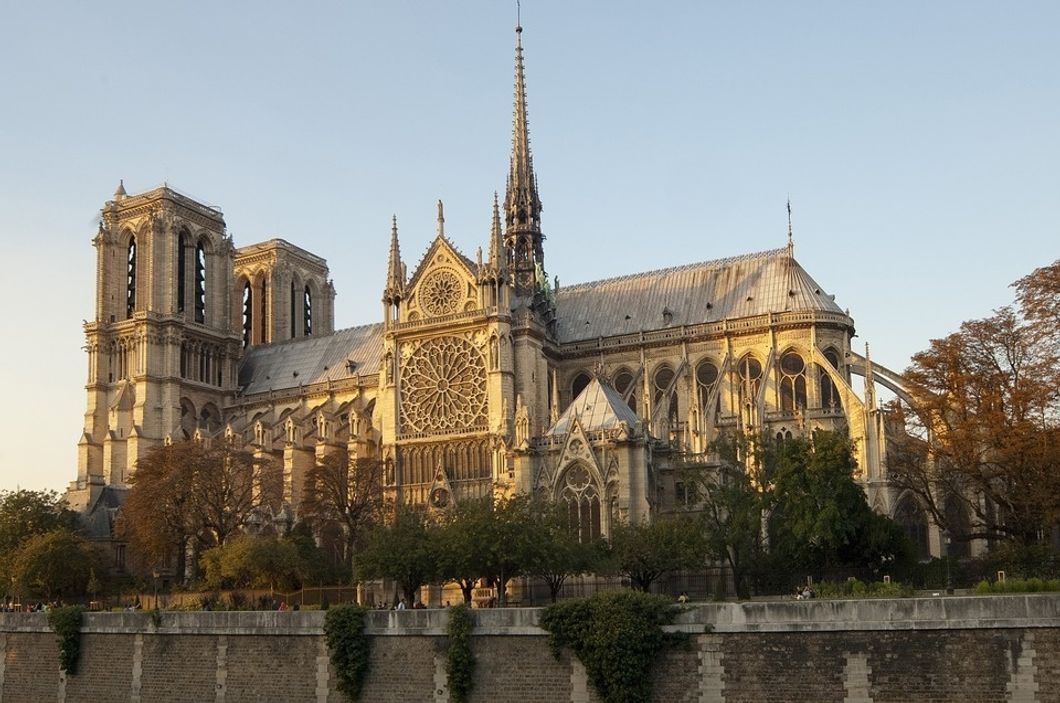A Tribute To Notre Dame
For many, the Notre Dame is more than a treasured vacation memory, more than a religious pillar, more than all-encompassing piece of art or history.
The Notre Dame Cathedral is one of France's most beloved structures. So to see it earlier this month, engulfed in flames that ultimately lead to the collapse of one of the most recognizable spires on Earth, broke the heart of millions of people.
In response to the fires, an outpouring of grief, love, and support flooded social media and Paris was on the mind of everyone who held such a high appreciation for the city's famous Cathedral.
Construction began in 1163 and the final touches were made in 1345, making it a symbol of hope and endurance 182 years in the making. It has been called many things: a jewel of medieval Gothic architecture, a pinnacle of European civilization, and a symbol of French culture.
As someone who was not nearly as emotionally attached to this piece of French history, I was both confused and intrigued in the overwhelming amount of sorrow present as I scrolled through social media. I wondered, what made it any different from the hundreds of church fires that have occurred anywhere else?
I watched as thousands of French citizens lined the streets, moved to tears and struck so heavily by what was unfolding, some to the point that they were unable to speak.
Someone close to me expressed heartbreak over the fires in such a way that I was compelled to do more research, to figure out why this Cathedral means so much the souls of so many people, and after hours of reading about it and its history, I finally began to understand.
What makes the Notre Dame Cathedral so incredible is its ability to connect those from every single walk of life. I read stories from Athiest's whose appreciation rivaled that of the most devout religious believers. I read about historians and scientists who shared the same level of wonder and awe about its construction and preservation over the decades. It is revered just as greatly to some Americans as it is to those with which it occupies the same city.
Notre Dame stood intact through the duration of two world wars and the French revolution. It's withstood economic crises, humanitarian crises, and countless protests on the streets of Paris.
It isn't merely a church, it's a piece of Paris, a piece of France, built to stand the test of time. A reminder of what their country has endured and a symbol to other countries of lasting human accomplishment, of generations upon generations of hard work.
In my quest to learn more about Notre Dame, I realized that I too hold a very small piece of this place close to my heart without even realizing it, through Victor Hugo and his beautifully written "The Hunchback of Notre Dame." Hugo writes about the Cathedral at the beginning of book three, summarizing the reason that Notre Dame has prevailed and will continue to prevail in the hearts of everyone who loves it, regardless of whether it remains unharmed or standing.
"Great edifices, like great mountains, are the work of centuries. Art often undergoes a transformation while they are pending, pendent opera interrupta; they proceed quietly in accordance with the transformed art. The new art takes the monument where it finds it, incrusts itself there, assimilates it to itself, develops it according to its fancy, and finishes it if it can. The thing is accomplished without trouble, without effort, without reaction,— following a natural and tranquil law. It is a graft which shoots up, a sap which circulates, a vegetation which starts forth anew. Certainly there is matter here for many large volumes, and often the universal history of humanity in the successive engrafting of many arts at many levels, upon the same monument. The man, the artist, the individual, is effaced in these great masses, which lack the name of their author; human intelligence is there summed up and totalized. Time is the architect, the nation is the builder. […]"
"All these shades, all these differences, do not affect the surfaces of edifices only. It is art which has changed its skin. The very constitution of the Christian church is not attacked by it. There is always the same internal woodwork, the same logical arrangement of parts. […] The service of religion once assured and provided for, architecture does what she pleases. Statues, stained glass, rose windows, arabesques, denticulations, capitals, bas-reliefs,—she combines all these imaginings according to the arrangement which best suits her. Hence, the prodigious exterior variety of these edifices, at whose foundation dwells so much order and unity. The trunk of a tree is immovable; the foliage is capricious."
We such much of what Hugo describes happening now, in the wake of the fires. Different people with different interests and backgrounds, and different reasons for loving Notre Dame, all coming together to mourn and celebrate the combined beauty of art, religion, architecture, history. Just as he believes that there is no individual artist of Notre Dame, there is no individual group who reserves the right to be heartbroken at its destruction.
The Notre Dame Cathedral is a place unlike any other, a place that millions of piece have attached a piece of themselves to, for any number of reasons. But the foundation of why this structure has so long been revered is simple: beauty and perseverance. Some find beauty in the religious symbolism. Others in the awe-inspiring architecture, the artistic universe within its walls, the historic significance, and some in the city itself. Some in the literature it inspired, and some in the years it took to construct.
We all have a tendency to attach ourselves to beauty, in whatever form it takes. We set aside space in our hearts and in our souls for extraordinary, beautiful things. For many, the Notre Dame is more than a treasured vacation memory, more than a religious pillar, more than all-encompassing piece of art or history. It's a thing of priceless beauty. A source of magic, and inspiration, and hope. Something I'm glad I can now appreciate.
What lies beneath the ash and rubble of a once whole masterpiece is something that can never be erased. Or burned. Or torn down, or replaced, or ignored, and that's the love and appreciation of those who hold this landmark so close to their hearts.


































